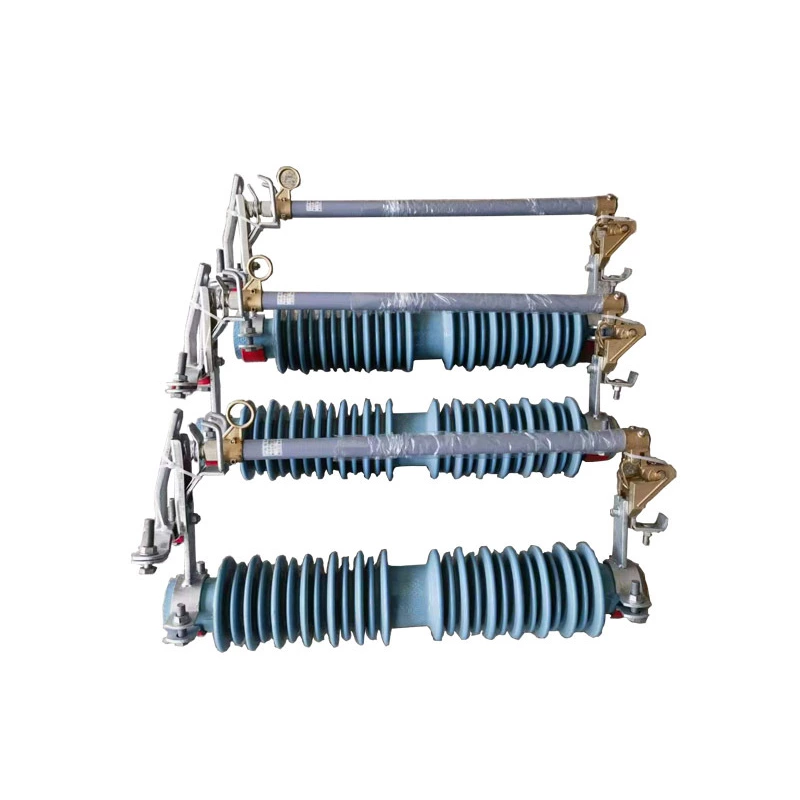Causes And Technical Analysis Of Abnormal Falling Of Drop-out Type Fuse
3、 Environmental interference effect
Wind disturbance
Wind force 8 (wind speed 17.2 m/s) generates aerodynamic torque on the melting tube:
𝑀𝑤=0.5⋅𝜌⋅𝑣²⋅𝐶𝑑⋅𝐴⋅𝐿
Among them, the air density is ρ=1.225kg/m ³, the resistance coefficient Cd is ≈ 1.2, the wind area A is 0.15m ², the force arm L is 0.3m, and the calculated MW is ≈ 12N · m, exceeding the design wind resistance capacity (8N · m).
Ice covered load
When the thickness of the ice layer is greater than 5mm, the additional mass increases the offset of the center of gravity of the melt tube by 40%, and the overturning moment is increased to:
In the equation M 𝑖𝑐𝑒=𝑚𝑖𝑐𝑒⋅𝑔⋅𝑙⋅ sin 𝜃, the value of m_ice is approximately 1.2kg (ice density 0.9g/cm ³), resulting in an imbalance of the total torque.
Temperature alternating stress
When the temperature difference between day and night is greater than 30 ℃, the difference in thermal expansion coefficient between aluminum melt pipes and steel supports (α _ Al=23 × 10 ⁻⁶/℃ vs α _ Fe=12 × 10 ⁻⁶/℃) generates shear stress greater than 15MPa, causing structural deformation.
4、 Improper operation and maintenance
Installation parameter deviation
If the installation angle of the melting tube is greater than 45 ° or less than 30 °, the gravity self-locking mechanism will be destroyed; The pre tightening force of the bolt is less than 20N · m (standard 25-30N · m), resulting in a 30% reduction in the contact area of the contact.
Missing detection cycle
Failure to regularly measure spring stiffness (cycle>3 years) and circuit resistance (cycle>1 year) prevents potential defects from being exposed in a timely manner.
Non standard operation
Using a non insulated operating rod (withstand voltage<30kV) to forcibly reset, causing secondary mechanical damage or insulator cracks (propagation rate>0.1mm/time).
5、 Systematic prevention and control plan
Structural reinforcement design
Adopting a dual redundant spring set (main spring 22N/mm, secondary spring 8N/mm), it can still provide 70% driving force when a single spring fails.
The shaft system is replaced with PTFE-GCr15 composite material, with a stable friction coefficient of 0.12-0.18 (operating conditions from -40 ℃ to 150 ℃).
Intelligent monitoring system
Deploying vibration temperature current fusion sensors:
Three axis vibration monitoring (threshold: axial>0.5g, radial>1.2g)
Fiber optic temperature measurement (accuracy ± 0.5 ℃, sampling rate 1Hz)
High frequency current recording (bandwidth 0-10MHz)
Environmental adaptability renovation
By installing NACA wing shaped deflectors, the aerodynamic drag coefficient has been reduced from 1.2 to 0.7, and the critical wind resistance level has been raised to level 10 (24.5m/s). Spray superhydrophobic coating (contact angle>150 °) on the surface of the melting tube, reducing the adhesion of the ice layer by 80%.
Standardized operation and maintenance process
Establish a full lifecycle archive, with key parameters including:
Number of spring operations (replacement threshold 2000 times)
Contact resistance historical data (warning when fluctuation rate>20%)
Environmental exposure index (triggering anti-corrosion maintenance when salt spray level>C4)
VI Conclusion
The abnormal drop of drop out fuse is the result of the coupling effect of multiple factors such as mechanical, electrical, and environmental factors. Drop out fuses can reduce the failure rate to below 0.03 times per hundred units per year through collaborative control of structural optimization, intelligent sensing, and standardized operation and maintenance, providing high reliability fault isolation guarantee for new power systems.

